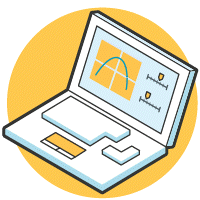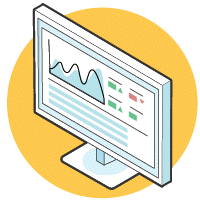Student success is the foundation of every higher education institution—whether this means improving graduation rates, ensuring more students get a degree sooner, or reducing the number of students who drop out before graduating. When students are engaged both academically and socially, they’re far more likely to perform better, stay motivated, and achieve their academic goals. Similarly, online institutions are mandated to improve student success rates, especially since retention rates traditionally lag behind seated courses.
So, how can you ensure students are staying engaged and meeting their academic goals when enrolling in your online programs?
Teaching STEM in an Online Environment
Below are three techniques that educators at Southern New Hampshire University (SNHU), University of Waterloo, and Chalmers University of Technology are using to improve student success and increase pass rates for online STEM classes.

1. Apply technology as an enabler to learning.
Rather than seeing technology as a delivery mechanism, use technology to enrich your students’ online education. If you’re using your online learning platform to simply digitize static learning material or replicating the textbook experience online, you’re missing an opportunity to tap into active learning.
The Möbius Platform lets you integrate active learning principles into your lesson material. Reimagine your online courses as immersive learning environments for your students with dynamic and interactive elements that respond to their input and adapt to their level of understanding. With the focus of “learning by doing,” your students are encouraged to explore concepts in greater depth. Paired with meaningful, instant feedback, Möbius provides a safe environment where students can evaluate their understanding as soon as they complete a task, assignment, or assessment. It also provides the incentive to review their work and sharpen their skills independently—building their confidence and ultimately resulting in better outcomes.

2. Leverage available data to understand the effectiveness of your learning materials.
Online courses offer a click-level understanding of how students are consuming content, from every keyboard stroke to interacting with their device screen. This direct feedback provides insight on how your students are responding to your learning material and where they may be struggling. Access to this data provides a clear roadmap for you to refine and evolve your curriculum to improve student outcomes. It serves as a powerful tool to meet the needs of continuous improvement initiatives, without the guesswork. The Möbius platform, for example, provides insights like:
-
- where students performed the best versus where students performed poorly;
- the distribution of time spent on lessons and assignments;
- engagement with drill and practice activities;
- and days/times where students are most active with their learning materials.
3. Foster a positive and constructive learning environment and guide them to success.
Administering your courses online shouldn’t disconnect you from your students—communicate and interact with them. For example, Southern New Hampshire University (SNHU) paired automatic marking with personalized feedback to create ongoing dialogue with their students. By using the Möbius platform, SNHU instructors were able to provide richer conversations and opportunities for dialogue about the thinking and reasoning behind earned grades and student responses. This level of student connectedness lets them know you’re invested in their success and helps set the tone for engagement throughout the course.
Online interaction with peers also helps develop a sense of community and improves the likelihood of student success. University of Waterloo incorporated gamification into their online math courses to motivate students to practice math problems. Experiential learning activities, such as online escape rooms, that step students through key concepts from their lesson material as a team, is one example of how to encourage regular peer interactions, which can have a positive impact on the student’s motivation to continue their learning journey.
By following these approaches, you can build an online environment where not only students will achieve their goals but your institution becomes a place where students will succeed.
Are You Ready to Improve Student Success Rates for Your Online Courses?
Möbius is an interactive learning platform that’s transforming online education for students and educators. Providing lessons, assessments, and interactive learning activities, Möbius unfolds the potential for students, particularly in STEM courses, to acquire knowledge at a guided yet self-defined pace. Let us show you how your students can perform better, stay motivated, and achieve their academic goals. Chat with us today!


